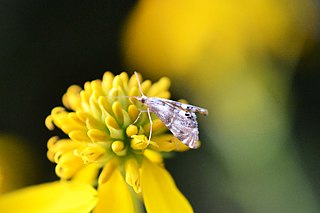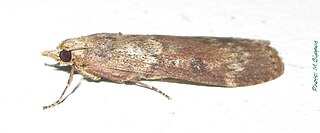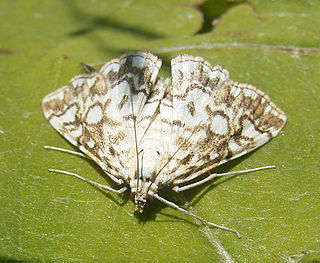Erpis is a genus of moths of the family Crambidae. It was described by Francis Walker in 1863. It contains only one species, Erpis macularis, which is found on Borneo.
Luma is a genus of moths of the family Crambidae. The genus was erected by Francis Walker in 1863.

Petrophila is a genus of moths of the family Crambidae. The genus was described by Lansdown Guilding in 1830.
Cobubatha is a genus of moths of the family Noctuidae. It was erected by Francis Walker in 1863.

Lamoria is a genus of small moths belonging to the family Pyralidae.

The Chrysauginae are a subfamily of snout moths. They are primarily Neotropical and include about 400 described species.
Aurana is a genus of snout moths. It was erected by Francis Walker in 1863 and is known from Japan and Australia.

Bostra is a genus of snout moths. It was described by Francis Walker in 1863 and is known from Ethiopia, Mozambique, India, and Turkey.

Aurana actiosella is a species of snout moth in the genus Aurana. It was described by Francis Walker in 1863 and is found in Australia.
Bostra illusella is a species of snout moth in the genus Bostra. It was described by Francis Walker in 1863. It is found in Sri Lanka.

Calguia defiguralis is a species of snout moth in the genus Calguia. It was described by Francis Walker in 1863. It is found in Borneo and Guangdong, China. It has also been recorded from Australia, Sri Lanka and Taiwan.
Jocara is a genus of snout moths. It was described by Francis Walker in 1863.
Etiella scitivittalis is a species of snout moth in the genus Etiella. It was described by Francis Walker in 1863. It is found in Australia.
Lamacha is a monotypic genus of snout moths. It was described by Francis Walker in 1863 and contains the species Lamacha bilineolata. It is found in China.
Marisba is a monotypic snout moth genus. Its one species, Marisba undulifera, was described by Francis Walker in 1863, and is known from Brazil.
Murgisca is a genus of snout moths. It was described by Francis Walker in 1863.
Murgisca cervinalis is a species of snout moth in the genus Murgisca. It was described by Francis Walker in 1863, and is known from the Dominican Republic.

Acentropinae is a fairly small subfamily of the lepidopteran family Crambidae, the crambid snout moths. Species of this subfamily are exclusively found in wetlands and aquatic habitats.

Parachma is a genus of snout moths. This genus is allied to Caphys Walker, 1863Acallis Ragonot, 1891 and Zabobar Dyar, 1914.

Midilinae is a subfamily of the lepidopteran family Crambidae. It was described by Eugene G. Munroe in 1958.






